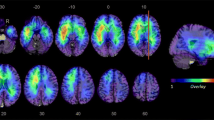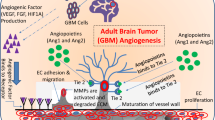Abstract
To investigate the relationship between placenta growth factor (PlGF) and brain tumor angiogenesis, we screened 36 primary and 3 metastatic brain tumors. We examined the expression of PlGF mRNA with respect to vasculature of various tumors which was determined by preoperative angiography. The expression of genes of the other angiogenic factors, vascular endothelial growth factor (VEGF), and basic fibroblast growth factor (bFGF) was also tested, and compared to that of PlGF. The primary tumors consisted of 16 meningiomas, 7 gliomas, 7 schwannomas, 4 pituitary adenomas, 1 germinoma, and 1 choriocarcinoma. Using a quantitative reverse transcription-polymerase chain reaction, the mRNA for PlGF149 and PlGF170 were detected in 25 out of 39 (64.1%) brain tumors. In primary brain tumors, PlGF mRNA was expressed in all the hypervascular tumors, but only in 5 of 16 hypovascular tumors (31.3%). None of the 3 metastatic hypervascular tumors expressed PlGF mRNA. The VEGF and bFGF mRNA expression was both detected in 87.2% of the tumors examined. We conducted hypoxic experiments with cultured U-251MG human glioma cells to determine the mechanism of PlGF gene regulation. As the atmospheric oxygen concentration was decreased, the PlGF mRNA level in the U-251MG cells was markedly increased. These results suggest that PlGF may contribute to the pathogenesis of brain tumor angiogenesis.
Similar content being viewed by others
References
Folkman J, Shing Y: Angiogenesis. J Biol Chem 267: 10931–10934, 1992
Folkman J, Haudenschild C: Angiogenesis in vitro. Nature 288: 551–556, 1980
Folkman J: What is the evidence that tumors are angiogenesis dependent? J Natl Cancer Inst 82: 4–6, 1990
Liotta LA, Steeg PS, Stetler-Stevenson WG: Cancer metastasis and angiogenesis: an imbalance of positive and negative regulation. Cell 64: 327–336, 1991
Heldin C-H: Structual and functional studies on platelet-derived growth factor. EMBO J 11: 4251–4259, 1992
Sato Y, Tsuboi R, Lyons R, Moses H, Rifkin DB: Characterization of the activation of latent TGF-β by co-cultures of endothelial cells and pericytes or smooth muscle cells: a self-regulating systems. J Cell Biol 111: 757–763, 1990
Schweigerer L, Neufeld G, Friedman J, Abraham JA, Fiddes JC, Gospodarowicz D: Capillary endothelial cells express basic fibroblast growth factor, a mitogen that promotes their own growth. Nature 325: 257–259, 1987
Leung DW, Cachianes G, Kuang W-J, Goeddel DV, Ferrara N: Vascular endothelial growth factor is a secreted angiogenic mitogen. Science 246: 1306–1309, 1989
Maglione D, Guerriero V, Viglietto G, Delli-Bovi P, Persico G: Isolation of a human placenta cDNA coding for a protein related to the vascular permeability factor. Proc Natl Acad Sci USA 88: 9267–9271, 1991
Wickbom I: Tumor circulation. In: Newton TH, Potts DG (eds) Radiology of the Skull and Brain. CV Mosby, St. Louis, vol 2 2257–2285, 1974
Yamagishi S, Yonekura H, Yamamoto Y, Katsuno K, Sato F, Mita I, Ooka H, Satozawa N, Kawakami T, Nomura M, Yamamoto H: Advanced glycation end products-driven angiogenesis in vitro. Induction of the growth and tube formation of human microvascular endothelial cells through autocrine vascular endothelial growth factor. J Biol Chem 272: 8726–8730, 1997
Nomura M, Yamagishi S, Harada S, Hayashi Y, Yamashima T, Yamashita J, Yamamoto H: Possible participation of autocrine and paracrine vascular endothelial growth factors in hypoxia-induced proliferation of endothelial cells and pericytes. J Biol Chem 270: 28316–28324, 1995
Takahashi A, Sasaki H, Kim SJ, Tobisu K, Kakizoe T, Tsukamoto T, Kumamoto Y, Sugimura T, Terada M: Markedly increased creased amounts of messenger RNAs for vascular endothelial growth factor and placenta growth factor in renal cell carcinoma associated with angiogenesis. Cancer Res 54: 4233–4237, 1994
Brogi E, Winkles JA, Underwood R, Clinton SK, Alberts GF, Libby P: Distinct patterns of expression of fibroblast growth factors and their receptors in human atheroma and nonatherosclerotic arteries. J Clin Invest 92: 2408–2418, 1993
Hauser S, Weich HA: A heparin-binding form of placenta growth factor (PlGF-2) is expressed in human umbilical vein endothelial cells and in placenta. Growth Factors 9: 259–268, 1993
Ferrara N, Henzel WJ: Pituitary follicular cells secrete a novel heparin-binding growth factor specific for vascular endothelial cells. Biochem Biophys Res Commun 161: 851–858, 1989
Gospodarowicz D, Abraham JA, Schilling J: Isolation and characterization of a vascular endothelial cell mitogen produced by pituitary-derived folliculo stellate cells. Proc Natl Acad Sci USA 86: 7311–7315, 1989
Barleon B, Sozzani S, Zhou D, Weich HA, Montovani A, Marmé D: Migration of human monocytes in response to vascular endothelial growth factor (VEGF) is mediated via the VEGF receptor-flt-1. Blood 87: 3336–3343, 1996
Weindel K, Moringlane JR, Marmé D, Weich HA: Detection and quantification of vascular endothelial growth factor/vascular permeability factor in brain tumor tissue and cyst fluid: the key to angiogenesis? Neurosurgery 35: 439–449, 1994
DiSalvo J, Bayne ML, Conn G, Kwok PW, Trivedi PG, Soderman DD, Palisi TM, Sullivan KA, Thomas KA: Purification and characterization of a naturally occurring vascular endothelial growth factor. Placenta growth factor heterodimer. J Biol Chem 270: 7717–7723, 1995
Maglione D, Guerricro V, Viglietto G, Ferraro MG, Aprelikova O, Alitaro K, Del Vecchio S, Lei KJ, Chou JY, Persico MG: Two alternative mRNAs coding for the angiogenic factor, placenta growth factor (PlGF), are transcribed from a single gene of chromosome 14. Oncogene 8: 925–931, 1993
Gleadle JM, Ebert BL, Firth JD, Rateliffe PJ: Regulation of angiogenic growth factor expression by hypoxia, transition metals, and chelating agents. Am J Physiol 268: C1362–C1368, 1995




